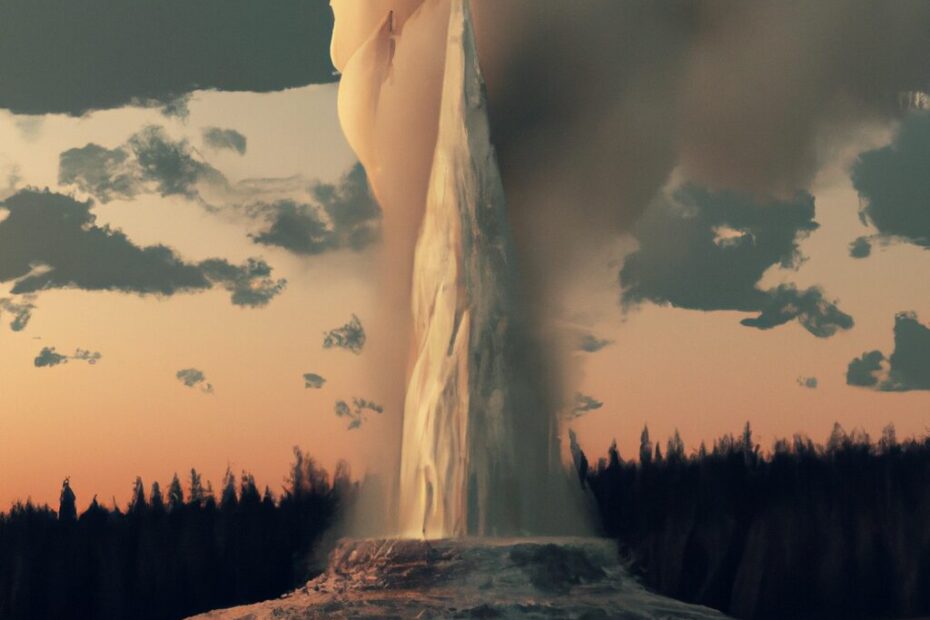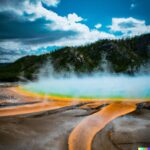Old Faithful, the iconic geyser in Yellowstone National Park, is a must-see natural wonder for visitors. In this article, we will explore the fascinating eruption schedule of Old Faithful in 2024. We will answer common questions such as when does Old Faithful erupt, how often does it erupt, and what factors affect its eruption schedule.
We’ll provide tips on the best time to witness this incredible display, as well as other geysers to visit in Yellowstone National Park. If you’re planning a trip to this beautiful park, read on to learn all about the awe-inspiring Old Faithful and its fellow geysers.
What is Old Faithful?
Old Faithful is a renowned geothermal geyser located in Yellowstone National Park, known for its spectacular eruptions and significant geological features.
This iconic geyser is one of the most predictable natural phenomena on Earth, erupting approximately every 90 minutes. Its eruptions can reach heights of 106 to 184 feet, captivating visitors with the raw power of Mother Nature.
The geothermal activity that fuels Old Faithful is a result of the park’s location atop a massive supervolcano and is surrounded by unique geological features such as hot springs and mud pots, making it a prominent attraction within Yellowstone National Park.
When Does Old Faithful Erupt?
The eruption of Old Faithful follows a predictable schedule, allowing visitors to witness this captivating natural wonder at specific intervals.
What Is the Eruption Schedule of Old Faithful?
The eruption schedule of Old Faithful is meticulously studied and monitored through geothermal and geological observations to predict its awe-inspiring eruptions.
Scientists have conducted extensive geological studies of the surrounding area, providing valuable insights into the underlying processes driving the eruptions of Old Faithful geyser. Geothermal monitoring is also crucial in tracking temperature and pressure changes within the hydrothermal system, offering vital data for predicting the timing and intensity of eruptions.
This combination of geological and geothermal investigations allows for a thorough understanding of the predictable patterns exhibited by Old Faithful, enabling researchers to accurately predict its breathtaking displays of natural phenomena.
How Often Does Old Faithful Erupt?
Old Faithful, like other geysers in Yellowstone, undergoes periodic eruptions, contributing to the captivating series of natural phenomena and geological events within the park.
What Is the Average Time Between Eruptions?
The average time between eruptions for Old Faithful is a result of intricate geological processes and the geyser’s rich volcanic history, shaping its unique eruption patterns.
The timing of Old Faithful’s eruptions is a key aspect influenced by the underlying geological processes and the geyser’s volcanic history.
This geyser has established a distinct pattern of eruptions, with intervals that typically range from 60 to 110 minutes. These intervals reflect the interplay of geological factors, such as the buildup of pressure within the geyser and the underlying volcanic activity.
The regularity of these patterns highlights the enduring influence of geological processes in shaping the behavior of this iconic natural wonder.
What Factors Affect Old Faithful’s Eruption Schedule?
Several factors influence the eruption schedule of Old Faithful, including geothermal activity, underground water systems, seismic activity, and geological trends.
Geothermal Activity
The geothermal activity in the region profoundly affects the behavior of Old Faithful, reflecting the complex geology of Yellowstone and the abundance of geothermal energy sources.
The unique geological features of Yellowstone, such as the presence of a hotspot beneath the Earth’s crust, contribute to the intense geothermal activity in the area. This, in turn, fuels the spectacular eruptions of Old Faithful.
The interconnected underground systems of hot water and steam create the perfect conditions for the geyser’s predictable eruptions. The potential for harnessing geothermal energy from Yellowstone’s geology presents an exciting prospect for sustainable energy sources, tapping into the natural heat reservoirs deep beneath the Earth’s surface.
Underground Water Systems
The intricate network of underground water systems, particularly the hydrothermal system, plays a pivotal role in shaping Old Faithful’s eruptions, requiring extensive geological investigations for comprehensive understanding.
The hydrothermal system beneath Yellowstone National Park, where Old Faithful is located, is a complex interplay of heated groundwater and geological structures, influencing the geyser’s eruptions. A thorough investigation of its geological dynamics is crucial for gaining insights into the behavioral patterns and eruption intervals of this iconic natural marvel. Understanding the intricate interactions of the hydrothermal system with the geyser’s activity is essential for the preservation of this unique geological phenomenon.
Earthquakes
Seismic activity and related geological reports provide valuable insights into the impact of earthquakes on Old Faithful’s eruption patterns, demonstrating the dynamic nature of this geological phenomenon.
The correlation between seismic activity and the behavior of Old Faithful has been extensively studied through geological reports. These reports have highlighted the influence of earthquake-induced changes in the underground hydrothermal system, which can affect the timing and intensity of the geyser’s eruptions.
Researchers have observed fluctuations in the intervals between eruptions following significant seismic events, emphasizing the interconnectedness of geological processes. This understanding is crucial for predicting and managing the behavior of geysers in seismic-prone regions, contributing to research on the complex interactions between seismic activity and geothermal features.
How Accurate is the Eruption Schedule for Old Faithful?
The accuracy of the eruption schedule for Old Faithful is continually refined through meticulous data analysis and thorough examination of geological trends and historical eruption records.
This data analysis involves the collection and interpretation of various parameters such as the duration and height of eruptions, intervals between eruptions, and the geological phenomena surrounding the geyser. By studying trends observed in the data, scientists can make informed predictions about Old Faithful’s eruptions.
Historical eruption records play a crucial role in validating these predictions, offering insights into the geyser’s behavior over time. The combination of meticulous analysis and historical context ensures the precision of Old Faithful’s eruption schedule.
What Is the Best Time to See Old Faithful Erupt?
Old Faithful offers captivating eruptions throughout the day, with morning, midday, and evening displays showcasing the geyser’s captivating natural spectacle.
Morning Eruptions
Morning eruptions of Old Faithful offer a mesmerizing sight, with distinct geyser patterns and precise geological measurements adding to the allure of the spectacle.
Visitors can marvel at the rhythmic bursts of water and steam, rising with impeccable timing from the earth’s depths.
The intricate layers of sediment and the meticulous documentation of these eruptions provide valuable insights into the geological activity of the region. It’s a fascinating intersection of natural wonder and scientific exploration, where the captivating beauty of the geyser patterns is complemented by the precision of geological measurements.
Midday Eruptions
Midday eruptions of Old Faithful provide opportunities for valuable geological findings and geothermal observations, enriching the understanding of this natural phenomenon.
Geysers, such as Old Faithful, provide scientists and researchers with the opportunity to closely examine geothermal activity. This makes it an ideal location for monitoring and studying changes in geothermal patterns over time.
By observing these eruptions, valuable insights into the Earth’s geology and internal processes can be gained. This contributes to ongoing research on geothermal energy and a broader understanding of our planet’s natural geological phenomena.
Evening Eruptions
Evening eruptions of Old Faithful contribute to the accumulation of valuable eruption data and geological evidence, furthering scientific understanding of this captivating natural phenomenon.
These evening eruptions offer researchers the opportunity to gather crucial data on the frequency, duration, and intensity of the volcanic activity.
Through the meticulous analysis of geological evidence associated with the evening eruptions, scientists can gain insights into the underlying processes that drive the eruption cycles of Old Faithful. This data not only enhances our comprehension of the intricate workings of this iconic geyser but also contributes to broader research on geothermal systems and volcanic phenomena.
What Other Geysers Can Be Seen in Yellowstone National Park?
In addition to Old Faithful, Yellowstone National Park features several other remarkable geysers, including the Grand Geyser, Castle Geyser, and Riverside Geyser, each offering its own unique spectacle.
Grand Geyser
The Grand Geyser stands as a remarkable example of geothermal phenomena within Yellowstone National Park. Its unique characteristics and behaviors have attracted geological studies and scientific investigations.
The geyser’s impressive eruption patterns, reaching heights of up to 200 feet, have captured the attention of geologists and researchers. They are drawn to this natural wonder in an effort to understand the underlying geological processes at play.
The geyser’s recurrent intervals and majestic displays provide invaluable data for studying the dynamics of geothermal systems and their impact on the surrounding landscape. As one of the world’s tallest predictable geysers, Grand Geyser holds significant importance for geothermal research and serves as a captivating natural spectacle for visitors.
Castle Geyser
The Castle Geyser offers captivating displays that invite extensive geological measurements and geyser research, contributing to the broader understanding of geothermal activity within Yellowstone National Park.
During its eruptions, scientists have the opportunity to gather critical data related to temperature, pressure, and mineral composition. This aids in the study of the underlying geological processes and allows for a comprehensive exploration of the geyser’s behavior. It also provides valuable insights into the dynamics of geothermal systems.
Additionally, researchers can assess the duration and frequency of the eruptions, furthering our understanding of the complex interactions between water, heat, and the Earth’s crust. This data is crucial in advancing our knowledge of geothermal activity and its impact on the environment.
Riverside Geyser
The Riverside Geyser presents captivating geothermal observations and distinct geyser patterns, offering valuable insights into the diverse manifestations of geothermal activity within Yellowstone National Park.
Visitors are drawn to the unique appeal of Riverside Geyser, as it provides a mesmerizing display of natural elements in action. The intermittent eruptions and the rhythmic patterns of water and steam combine to create a striking spectacle that underscores the raw power and beauty of geothermal activity.
The geyser’s location along the Firehole River adds to its allure, allowing for a serene backdrop against which to witness these geothermal wonders. These geothermal observations and geyser patterns offer both a scientific and aesthetic experience for visitors, contributing to the geyser’s status as a must-see attraction within the park.
Frequently Asked Questions
When will Old Faithful erupt in 2024?
The exact date of Old Faithful’s eruption in 2024 cannot be predicted as it is a natural phenomenon. However, it typically erupts every 60-110 minutes, so visitors can expect to see an eruption multiple times throughout the day.
Will Old Faithful’s eruption schedule change in 2024?
The eruption schedule of Old Faithful is not expected to change significantly in 2024. However, it is important to note that the geyser’s eruptions can vary in duration and intensity from day to day.
What factors influence Old Faithful’s eruption schedule?
The eruption schedule of Old Faithful is primarily influenced by the amount and temperature of water in the geyser’s underground reservoir. Changes in these factors can cause variations in the geyser’s eruptions.
Can I see Old Faithful’s eruption on a specific day in 2024?
Due to the unpredictable nature of Old Faithful, it is not possible to guarantee that the geyser will erupt on a specific day in 2024. However, visitors have a high chance of witnessing an eruption during their visit.
How long does Old Faithful’s eruption last in 2024?
The duration of Old Faithful’s eruption can vary from 1.5 to 5 minutes in 2024. The length of the eruption is dependent on the amount of water in the geyser’s underground reservoir and can change from day to day.
Can I check the Old Faithful eruption schedule online?
Yes, the National Park Service provides a predicted eruption schedule for Old Faithful on their website. However, keep in mind that this schedule is an estimate and the geyser’s eruptions may vary from the predicted times.
Last Updated on January 26, 2024 by Jon Waraas – Originally Posted: January 26, 2024

I’m Jon Waraas, and I’ve been navigating the online world since 2006. By day, I’m the proud owner of some eCommerce gems, and by night, I’m the voice behind the adventures on Waraas.Com.
My heart, however, belongs to the wild beauty of Yellowstone National Park. I’ve got a collection of websites dedicated to sharing the wonders of this natural masterpiece. Oh, and did I mention? I’m currently building my own cabin inside the ghost town of Gilmore, Idaho – a cabin with tales to tell!
When I’m not immersed in the digital realm, you’ll find me lacing up my boots for a good hike or setting up camp under the star-studded sky.




